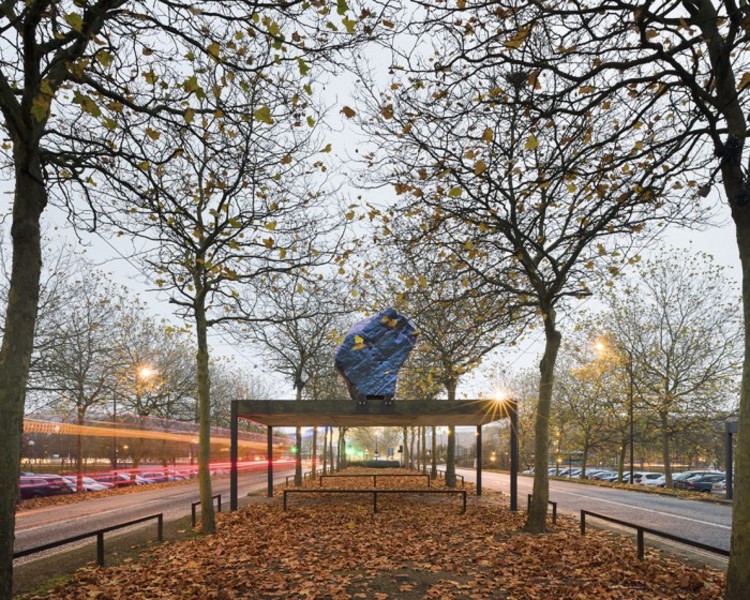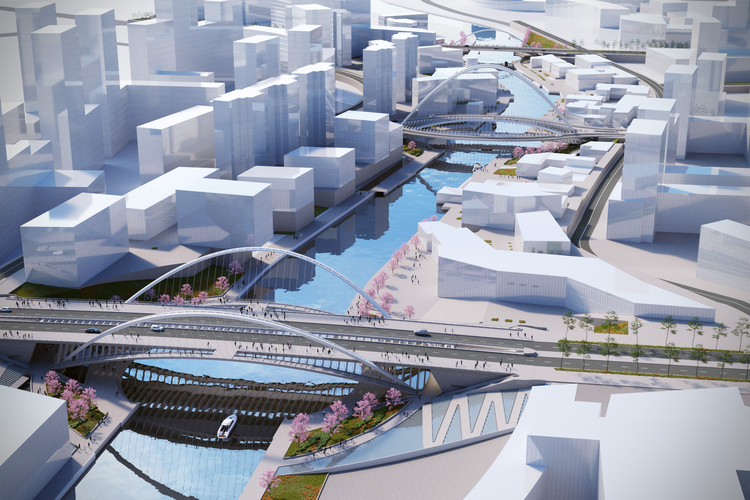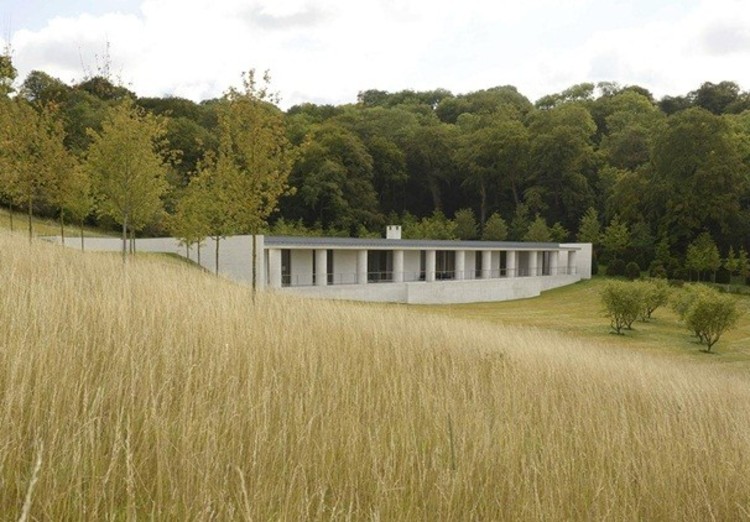
Work seamlessly with CAD and Lumion 3D rendering software for immediate model visualizations


Work seamlessly with CAD and Lumion 3D rendering software for immediate model visualizations

How much editing is acceptable in architectural photographs? And what if those edited photographs are the basis of judging a design competition? Chicago Tribune architecture critic Blair Kamin explored these questions in a recent column after an altered photo led to a Design Excellence Award from the Chicago chapter of the AIA. The building in question, the El Centro campus of Northeastern Illinois University designed by Juan Moreno, was one of five recipients of the chapter's honor award, the highest level of recognition. But one of photos submitted to the award jury had been digitally altered by the photographer to remove a prominent row of large air handling units on the roof that marred one of the best views of the building.

Iñaqui Carnicero and Carlos Quintáns have been selected as co-curators of the Spanish Pavilion at the Venice Architecture Biennale 2016, directed by Chilean architect Alejandro Aravena, under the theme "Reporting from the Front."
Iñaqui Carnicero is an architect and a Visiting Professor at Cornell University, and has been recognized by numerous international awards such as the Design Vanguard Award, AIANY Housing Award, Emerging Architects Award, FAD and COAM Award.
Carlos Quintáns is Professor of the Architectural Construction Department of the A Coruña Architecture School and director of the Tectónica magazine, recognized with awards such as the COAG, FAD or at the Spanish Architecture Biennale.
.jpg?1449862900)
Columbia University student and architectural photographer Songkai Liu has shared images with us from his recent trip to Grace Farms in New Canaan, Connecticut. The 80-acre non-profit farm, landscaped by OLIN, boasts a newly completed multipurpose pavilion designed by SANAA that provides a non-intrusive space for community events, services and worship.
"SANAA’s goal was to make the architecture of the River become part of the landscape without drawing attention to itself, or even feeling like a building, with the hope that those who are on the property will have a greater enjoyment of the beautiful environment and changing seasons through the spaces and experience created by the River," described the architect.

Venice, Berlin and New York City are the first to be featured in LEGO®'s new Architecture Skyline Collection. Unlike its single-building series, these new kits will allow you to recreate famous skylines by constructing up to 5 of each city's most iconic buildings.
New York City's skyline will be represented by the One World Trade Center, Empire State Building, Chrysler Building, Statue of Liberty, and Flatiron Building. Venice will feature the Rialto Bridge, St. Mark’s Basilica, St. Mark’s Campanile, St. Theodore and the Winged Lion of St. Mark, and the Bridge of Sighs. And Berlin's skyline will include the Reichstag, Victory Column, Deutsche Bahn Tower, Berlin TV Tower, and Brandenburg Gate.

Heatherwick Studio and Diamond Schmitt Architects have been chosen to collaborate on the "renovation and reimagination" of David Geffen Hall, Lincoln Center’s largest concert hall in New York City. The team, chosen through a two-year competition and over 100 firms, will design a 21st-century concert hall for the New York Philharmonic home and transform it into a center capable of hosting "a broader, ongoing array of community activities and events."
"The inspiring combination of Heatherwick and Diamond Schmitt will bring contemporary design excellence, respect for the historic architecture of the hall, and extensive experience creating acoustically superb performance halls," said Katherine Farley, chairman of Lincoln Center for the Performing Arts.

We’ve always been a profession of hackers. Every building is a one-off made up of countless elegant hacks, each bringing disparate materials and systems together into a cohesive whole. But when it comes to the software that designers have come to rely on, most of us have been content with enthusiastic consumerism, eagerly awaiting the next releases from software developers like Autodesk, McNeel (Rhino) and Bentley (MicroStation).
It’s been 5 years since we officially launched our research program at the Yazdani Studio of Cannon Design, and during that period we’ve come to understand the evolution of our process reflects the larger, changing relationship architects have with their means of production. Specifically, we've noticed that in late 2007 something changed. McNeel introduced a visual programming plugin called Grasshopper, and more and more architects began to hack their tools as well as their buildings.

London-based practice Sam Jacob Studio, led by a former partner of FAT, have installed a 1:1 replica of a standing sarsen stone from the Avebury stone circle in the centre of the British New Town of Milton Keynes. The 'MK Menhir', situated on a Porte Cochère on the city's Midsummer Boulevard, has been (CNC) milled from hard-coated foam using data from a 3D scan of the original stone. It has been given an iridescent tint using techniques similar to those used to spray paint a car.

Opened in January 2015, the Philharmonie de Paris was designed by Jean Nouvel, though he later distanced himself from the project. The concert hall, a 2400 seat venue, seeks to "invent a model all its own," according to the Philharmonie de Paris website. It breaks from the pack of concert halls by mathematically creating a more intimate space -- "the distance between conductor and the farthest spectator is only 32 metres (compared to 48 metres at the Salle Pleyel for a smaller audience)." The architect worked with various acoustic experts to "develop a bold system of cantilevered balconies and floating clouds, combining envelopment, intimacy and spaciousness." Here we see the project as photographed by Danica O. Kus. Read on for the full set.
.jpg?1449771318)
Still searching for the perfect gift for that hard to please architect in your life? No need to look any further, we've compiled a list of items any architect would love to receive. Read on to see ArchDaily’s top 16 gifts for architects!

Foster + Partners, HOK, BDP and Allies and Morrison have been shortlisted in a bid to "restore and renew" London's Palace of Westminster. As BD reports, the massive project is estimated to cost at least £3.5 billion and last more than six years (possibly up to 32 years). A team will be selected next year. Work will begin in 2020.

Developed by FilzFelt and Gensler’s LA office, “Link” modular felt panels can be used for a variety of applications, from room partitioning, to shading, to acoustical dampening, to adding textural interest to a wall surface. The panels were designed to tackle a particular design problem at Gensler’s LA office, where red glazed panels acting as an architectural statement to be viewed from the street had been casting a harsh light into the interior conference room space behind. Searching for a flexible, free-form solution, and a soft material to contrast with the hard glass, Gensler designers discovered wool felt. Enter “Link.”

Santiago Calatrava has been commissioned to design a trio of bridges in the Chinese city of Huashan, east of Wuhan. The three steel bridges - Xihu, Xianbi and Lincong - will span 1.5 kilometers of the city's new Yangtze River canal, providing access to pedestrians, cyclists and vehicles.
“Architecture is one of the art forms best able to improve and revitalize cities both artistically and functionally,” said Calatrava. “The Huashan project is a clear example of how an urban element, key to the successful growth of the city, can at the same time improve the quality of life for its citizens, thanks to an integration of all three bridges and the creation of boulevards on the banks of the canal.”

In 2010, following the election of a new mayor, the Moscow city government began to work towards a comfortable urban environment in which citizens would feel like residents rather than mere users of the city. The emphasis was on creating public spaces in which Muscovites could fulfill their potential and feel that the city was their home.
Gorky Park was at the forefront of the changes. During the 1990s, the "Central Park of Culture and Leisure" accumulated a collection of fairground rides and became a sort of amusement park popular principally among visitors from other cities; Muscovites hardly went there. Three years ago, the city government made it their mission to overturn the park's image and bring Moscow's residents back. A full-scale reconstruction and restoration began in spring 2011.
Today, Gorky Park is a new level of urban space – one centered around people and boasting a scrupulously conceived infrastructure. All of the changes were aimed at creating a comfortable environment for life - for strolling and sport, work and study, culture and leisure. Moreover, in a short time the park has developed an effective economic model whereby it receives one half of its budget from the city and generates the other half itself.

The Swiss Arts Council Pro Helvetia has nominated Christian Kerez, a Venezuela-born, Swiss architect, to represent Switzerland at the 15th Architecture Biennial in Venice in 2016. The exhibition will be curated by Swiss art historian Sandra Oehy, and will be on display at the Biennial from May 28 to November 27, 2016. Switzerland will also be represented by <<Salon Suisse>>, a platform for discussion and debate on contemporary art and architecture.

London-based practice Studio Egret West have developed designs for future London Underground stations which centre on a holistic approach to infrastructure design. The so-called 'Station Design Idiom' is, according to the designers, "deliberately wide-ranging." As a manifesto, it "covers small interventions, like repainting, through to full station refurbishments and new builds" and "complements existing London Underground standards and guidance and is the first port of call for all design decision-making on the network."
_HI_RES_(1).jpg?1449603126)
Swarovski commissioned FR-EE / Fernando Romero EnterprisE to design an installation for Design Miami/ that "explores man's relationship with the sun." One billion times smaller than the sun, the installation - El Sol - is a spherical geodesic dome made from 2880 Swarovski crystals that "augment light emitted from its core" to "evoke the sun's gaseous, moving terrain."
"The project has allowed me to explore mathematics in relation to nature and my Mexican ancestry, which is very important and personal to my practice," said Fernando Romero.

iGA has shared a glimpse of 6 proposed designs competing to be the Istanbul New Airport's Traffic Control Tower. With designs by Zaha Hadid, Moshe Safdie, Grimsaw-Nordic, Massimiliano Fuksas, Pininfarina-Aecom, and RMJM Architects, the competition seeks to chose an innovative tower that is "inspired by the authentic symbols of Turkey."
“We are developing a unique project inspired by the local architecture. That is why we have organized this contest, hoping that Airport Traffic Control Tower design would symbolically contribute great deal to Istanbul New Airport and also will be the most important figure of Istanbul. We particularly asked contestants to get inspired from icons of Turkey. Currently we are evaluating the submitted projects and will be announcing the results as soon as possible,” said Yusuf Akçayoğlu, CEO of İGA.

schmidt hammer lassen architects has won an international competition to masterplan a 87,000-square-meter area of Skøyen in central Oslo, dubbed Eureka Kvarteret. The multi-phased plan aims to unify the area's connection to the Oslo fjord, nearby transportation hubs and its main street, Hoff, while generating a versatile new skyline that compliments its context.
“We have proposed a framework that builds upon a basic idea about the space between the buildings," explains Senior Partner Kristian Lars Ahlmark.

It’s a topic that cannot be avoided for any longer. The ongoing Paris Climate Conference has seen an unprecedented amount of participation - even before the summit began, over 150 countries submitted national plans of action to the United Nations - and there seems to now be a global consensus that we must cut back on our energy use and reliance on carbon polluting fossil fuels, or risk causing irreversible damage to our planet. By the end of the conference, an agreement will likely outline energy-reducing strategies by which all countries must abide. For architects, this means fundamentally changing the ways we design buildings and determine their success. Traditional building and construction methods consume large quantities of natural resources and account for a significant portion of the greenhouse gas emissions that affect climate change. In the United States, the building sector accounts for 41 percent of the country’s energy usage, according to the U.S. Green Building Council.
But this information is hardly new, and thankfully, our profession has been preparing for this change for some time. In 2006, the American Institute of Architects became the first adopters of the 2030 challenge, a call for all new buildings, developments, and major renovations to reach carbon-neutrality by 2030, with milestone goals of reduced dependence at 10-year intervals along the way. Each year, the AIA releases a progress report outlining the current standing of energy consumptions and take-aways from their findings. This year’s key conclusion? We must start integrating energy modeling techniques earlier into the design process.

Assemble, a London-based collective who "work across the fields of art, design and architecture to create projects in tandem with the communities who use and inhabit them," have been announced as the winners of the 2015 Turner Prize – Europe’s most prestigious contemporary visual art award. Their nomination was a surprise to many, not least because an architect (or architecture collective, in this case) has not been shortlisted before. Previous winners—some of whose work has intersected with the world of architecture—include Gilbert & George, Anish Kapoor (known for the Orbit at the 2012 London Olympic Games), Antony Gormley, Damien Hirst, Gillian Wearing and Grayson Perry (a collaborator on FAT's final built work).

Ben Johnson is a painter preoccupied by realism – especially when it comes to the two-dimensional representation of architectural space. A British artist practicing in London, Johnson has been working professionally since the mid-1960s. In that time his extensive œuvre has encompassed painted cityscapes and prints to depictions of rooms designed—among others—by Norman Foster, John Pawson, I. M. Pei, and David Chipperfield.

An 1152-meter super tall tower is being proposed for the Iraqi city of Basra as part of a government-backed masterplan that aims to expand the city's capacity by 2025. As reported by Slate, the "Bride of the Gulf" was designed by AMBS Architects as a cluster of four net-zero towers interconnected by sky gardens and independent of the city grid. Together, they would add nearly 17-million-square-feet of usable space to the city's growing business center. Parks, "sky-squares," schools, hotels, clinics, commercial centers, offices and much more would provide all the amenities needed for a self-sustaining vertical city.

Deutsches Architekturmuseum (DAM) has been chosen to represent Germany at Venice Biennale 2016 with the exhibition Making Heimat. Germany, Arrival Country. The DAM team - including general commissioner and director Peter Cachola Schmal, curator Oliver Elser, and project coordinator Anna Scheuermann - has already begun to collect examples of buildings that are being transformed for refugees and migrants - from large reception centers to refugee-led bicycle workshops. All work will be presented to the public in early 2016 as "an information pool for planners and policy-makers."

Succeeding Peter Zumthor, David Chipperfield has been selected as the Rolex Mentor and Protégé Arts Initiative's new architecture mentor. The British architect will join six other "master artists" - Mia Couto (literature), Alfonso Cuarón (film), Philip Glass (music), Joan Jonas (visual arts), Robert Lepage (theatre) and Ohad Naharin (dance) - in selecting their own protégé from a pool of finalists this coming spring; mentoring will begin mid-2016.
But you can browse the last one: 417